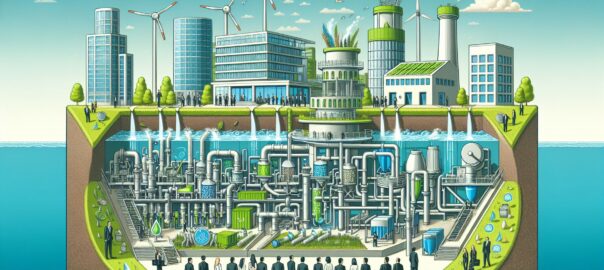Water is the most fundamental resource for sustaining life, economic development, and the environment. With the increasing demand for clean water due to population growth and industrialization, alongside the dwindling supply of freshwater resources, it becomes imperative to manage wastewater effectively. An integrated wastewater treatment system plays a significant role in ensuring water is recycled and reused responsibly. In this article, we will delve into what constitutes an integrated wastewater treatment system, its importance, components, and some of the challenges and solutions associated with implementing such systems.
Understanding Integrated Wastewater Treatment Systems
Integrated wastewater treatment systems are complex configurations that combine various processes and technologies to treat wastewater effluent to a level that is safe for discharge or reuse. These systems are designed to address a range of contaminants, including organic matter, nutrients, pathogens, and chemicals, in a holistic and efficient manner.
Why is Integration Important?
The concept of integration is crucial because single treatment processes often cannot meet the stringent discharge standards imposed by regulators. By combining physical, chemical, and biological methods, integrated systems leverage the strengths of various processes to achieve a high-quality effluent.
Moreover, an integrated approach ensures a system is resilient and adaptable. It can better handle fluctuations in wastewater composition, load, and volume, as well as respond to changes in regulatory requirements and technological advancements.
Key Components of an Integrated Wastewater Treatment System
-
Wastewater Collection: This is the starting point of the treatment journey. Sewage is collected from residential, commercial, and industrial sources and conveyed to the treatment plant.
-
Pretreatment: Large solids and grit are removed in this stage to protect the downstream processes from clogging and abrasion.
-
Primary Treatment: This phase involves the settling of suspended solids. Heavy particles settle at the bottom, forming sludge, while scum floats to the top.
-
Secondary Treatment: This biological treatment stage uses microorganisms to decompose organic matter in the wastewater.
-
Tertiary Treatment: Advanced treatments like filtration, disinfection, and nutrient removal further refine the water quality.
-
Sludge Treatment: The sludge produced during the process is treated and disposed of safely.
-
Effluent Disposal or Reuse: Treated water is discharged into water bodies or reused for various purposes, including irrigation and industrial processes.
Technology Integration and Advanced Monitoring
To enhance efficiency, modern integrated wastewater treatment systems deploy advanced technologies such as smart sensors, remote monitoring, and data analytics. These tools enable real-time monitoring and control, improving the responsiveness and reliability of the treatment process.
-
Wastewater Data Integration and Analytics: By collecting and analyzing data from various points in the treatment process, operators can optimize the performance and predict the need for maintenance or adjustments.
-
Integrated Wastewater Monitoring Systems: These systems gather information on water quality and system performance continuously, allowing for proactive interventions.
-
Wastewater SCADA System Integration: Supervisory Control and Data Acquisition (SCADA) systems enable centralized control of the treatment processes, enhancing automation and decision-making.
The Importance of Effective Management and Planning
Implementing an integrated wastewater treatment system requires careful management and strategic planning. Key considerations include:
-
System Design: The design must be tailored to the specific needs of the community it serves, considering factors like size, climate, and type of waste.
-
Operation and Maintenance: Ongoing operations need to be managed efficiently, with regular maintenance to ensure system longevity and reliability.
-
Regulatory Compliance: Meeting local and international standards is vital to protect public health and the environment.
-
Stakeholder Engagement: Involving all stakeholders, from policy-makers to the community, ensures the system meets the broader needs and receives the necessary support.
Challenges in Wastewater Treatment Integration
Despite the advantages, integrating wastewater treatment systems presents challenges such as:
-
High Capital and Operational Costs: The complexity of integrated systems often translates to significant investment costs and higher operational expenses compared to conventional treatment methods.
-
Technological Complexity: Managing advanced technologies requires skilled personnel and continuous training.
-
Scalability: As communities grow, systems need to be scalable to meet the increased demand without compromising performance.
Best Practices and Sustainable Solutions
To overcome these challenges, here are some best practices:
-
Lifecycle Management: A focus on the entire system lifecycle, from design to decommissioning, ensures sustainability and cost-effectiveness.
-
Adaptive Management: Systems should be designed with flexibility in mind, allowing for modifications and upgrades as conditions change.
-
Resource Recovery: Integrated systems can be designed to recover resources like nutrients and energy from wastewater, adding value and reducing waste.
-
Public-Private Partnerships: Engaging in partnerships can help share the financial burden and bring efficiency through private-sector innovation.
-
Education and Training: Investing in workforce development ensures the system is operated and maintained effectively.
Conclusion
Integrated wastewater treatment systems represent the future of sustainable water management. By combining various treatment processes and technologies, and harnessing the power of data and automation, these systems can effectively tackle the complex task of wastewater treatment in a holistic manner. While challenges exist, with thoughtful planning, stakeholder engagement, and adherence to best practices, we can ensure these systems serve our communities well into the future.
Sources
- Metcalf & Eddy, Inc. (2014). Wastewater Engineering: Treatment and Resource Recovery. McGraw-Hill Education.
- United States Environmental Protection Agency (EPA). (n.d.). Wastewater Technology Fact Sheet: SCADA and Automation. Retrieved from https://www.epa.gov
- World Health Organization (WHO). (2017). Guidelines for the Safe Use of Wastewater, Excreta, and Greywater. World Health Organization.
Please note that this article is for informational purposes only and does not replace professional engineering consultation.
